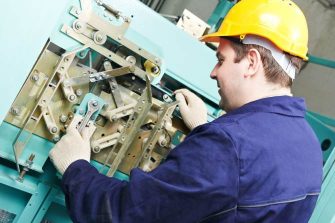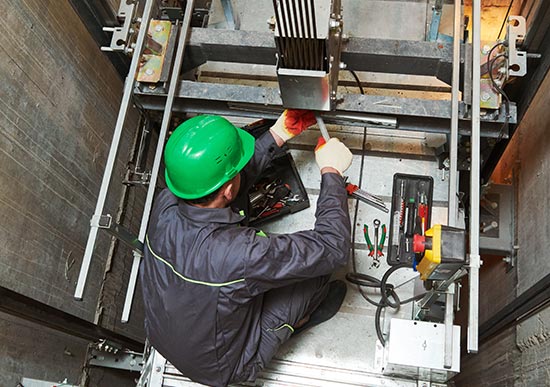Effective Lift Breakdown Solutions: What to Anticipate From Top Lift Repair Services
Effective Lift Breakdown Solutions: What to Anticipate From Top Lift Repair Services
Blog Article
Professional Tips for Ensuring Safety During Comprehensive Lift Fixing Treatments
In the realm of comprehensive lift fixing treatments, safety stands as a paramount concern that demands careful attention to detail and adherence to established procedures. As the complex interaction of machinery and human intervention unfolds, a tactical technique to safety ends up being the cornerstone for successful repair procedures.
Security Gear Needs
The security equipment requirements for lift fixing treatments are vital to make sure the well-being of upkeep employees. When working on lifts, upkeep employees need to stick to rigorous security protocols by putting on appropriate equipment such as hard hats, safety goggles, gloves, steel-toed boots, and high-visibility vests.
Tough hats are critical for securing against head injuries from bumping or falling things into above frameworks. Security safety glasses shield the eyes from debris, chemicals, or sparks that may be created during repair. Handwear covers offer hand defense from cuts, burns, or electrical shocks, while steel-toed boots provide foot defense from hefty objects or equipment. High-visibility vests guarantee that maintenance workers are quickly seen by others, decreasing the danger of crashes as a result of bad presence. By strictly sticking to safety and security equipment needs, upkeep workers can minimize risks and work effectively to keep and fix lifts.

Equipment Evaluation Checklist
To guarantee the upkeep employees's security and the correct performance of lifts, an extensive equipment inspection checklist is critical before starting any type of fixing treatments. lift service company. This checklist must include a complete examination of all parts such as cables, pulleys, electric systems, and safety and security mechanisms. It is critical to check for any type of signs of deterioration, corrosion, or damage that may endanger the lift's structural stability or functional efficiency
Along with mechanical components, the evaluation list ought to include safety functions like emergency brakes, limit buttons, and overload sensors. These safety mechanisms play an important duty in making certain and avoiding accidents user protection during lift operation.
Moreover, validating the calibration of control systems, validating proper ventilation and lights within the lift shaft, and inspecting for any blockages or debris are important action in the evaluation process. Routine upkeep and adherence to the tools inspection list not just boost safety and security procedures yet additionally expand the life-span of the lift system, lowering the probability of unforeseen failures or costly repair services.
Danger Recognition Strategies
Using systematic analysis approaches, danger recognition methods are utilized to pinpoint possible dangers within lift fixing procedures. These techniques include an extensive evaluation of the repair service environment, tools, and tasks included to recognize any risks that might lead to injuries or crashes. One common strategy is the Task Safety And Security Analysis (JSA), where each step of the fixing process is very carefully evaluated to identify prospective risks and determine the very best precaution to alleviate them. Additionally, Failing Setting and Results Analysis (FMEA) can be made use of to anticipate potential failing points in the repair treatment and establish safety nets to address them proactively.

Emergency Action Readiness
With a concentrate on making certain swift and reliable action to unpredicted situations, emergency situation action readiness is a crucial element of maintaining security throughout lift repair procedures. Focusing on emergency readiness entails developing clear communication channels, designating specific functions and responsibilities, and carrying out regular drills to examination response times and procedures.
Trick elements of emergency situation feedback readiness consist of having conveniently available emergency treatment kits, fire extinguishers, and emergency contact info plainly displayed. It is necessary to train all personnel entailed in lift repair procedures on emergency situation reaction procedures, including just how to safely evacuate the area in case of a fire or various other emergencies.
Moreover, establishing a comprehensive emergency feedback plan certain to raise fixing scenarios can aid lessen prospective dangers and guarantee a prompt and coordinated reaction in the event of an incident. Consistently updating this strategy and examining based on lessons learned from past drills or cases is important to continually boost precaution during lift fixing procedures.
Ongoing Safety And Security Training
Consistent education and training in safety procedures is an essential element of making sure the recurring security of workers throughout lift repair work procedures. Ongoing security training plays a vital function in maintaining employees notified regarding the most recent safety and security standards, procedures, and finest methods in the industry (lift breakdown). By offering routine training sessions, employees can stay current on potential risks, risk-free job treatments, and emergency procedures certain to lift repair work settings
Normal safety training also aids strengthen the importance of complying with security standards and procedures at all times. It imparts a safety-conscious frame of mind among workers, advertising a culture of safety within the work environment. Furthermore, continuous training allows workers home to rejuvenate their knowledge and abilities, improving their preparedness to take care of any unpredicted safety challenges that might emerge throughout lift repair work read what he said operations.
To guarantee the efficiency of ongoing safety training, it is vital to customize the web content to the details risks and demands linked with lift repair service procedures - lift repair. Employers ought to routinely analyze training demands, supply opportunities for hands-on practice, and encourage open communication regarding safety and security issues amongst all personnel entailed in lift fixing procedures
Verdict
To conclude, guaranteeing safety and security throughout comprehensive lift fixing procedures is necessary for avoiding injuries and crashes. By following safety and security gear demands, conducting tools examinations, recognizing threats, planning for emergency situations, and supplying ongoing safety and security training, employees can decrease dangers and produce a safe work setting. Focusing on safety and security procedures and remaining alert throughout the repair work process will certainly aid secure both employees and the equipment being serviced.
When functioning on lifts, maintenance workers need to stick to rigorous safety and security procedures by putting on suitable equipment such as tough hats, safety goggles, gloves, steel-toed boots, and high-visibility vests. One common method is the Job Safety And Security Analysis (JSA), where each action of the repair procedure is very carefully assessed to recognize possible dangers and establish the best safety and security actions to reduce them.Regular education and training in security procedures is a fundamental element of making certain the recurring safety of workers throughout lift repair treatments.Routine safety and security training additionally helps strengthen the relevance of following safety and security standards and procedures at all times. By complying with safety gear demands, carrying out equipment examinations, recognizing threats, preparing for emergencies, and providing ongoing safety and security training, workers can decrease risks and produce a secure work atmosphere.
Report this page